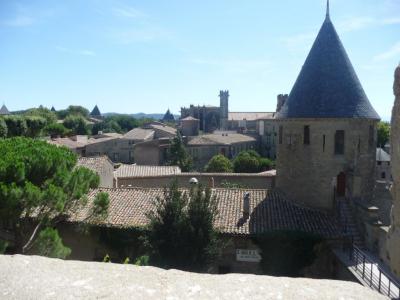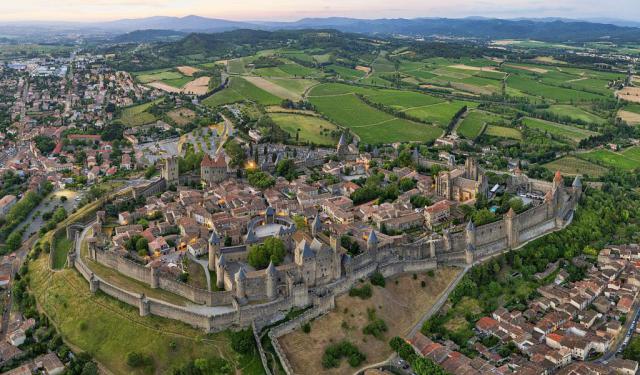Cité de Carcassonne (Fortified City of Carcassonne), Carcassonne (must see)
For almost all of its history, the fortified City of Carcassonne has been defended by its walls. The Cite itself goes back more than 2,000 years. It was an oppidum, a Celtic iron age strong point. In the 1st century BCE the Romans transformed it into a town. The Romans were followed by Visigoths, Omayyads and eventually, Crusaders.
In 1208 Pope Innocent III declared a crusade against the Albegensian Heresy. This was bad news for Cathar Raimond-Roger, Viscount of Trencavel and ruler of Carcassonne. The Cathars were evicted and Raimond died in his own donjon. In 1247 Louis VIII declared the Cite to be royal after the usual terror, massacres and yes, the Inquisition.
The Roman walls were gradually replaced by the 14th century. New walls were reinforced and lengthened and new towers built. In 1459 however, The treaty of the Pyrenees was signed with Spain. Carcassonne ceased to be an important military outpost and the fortifications fell into disrepair.
In 1849 the Government in Paris tried to demolish the fortifications in a deluded effort at urban renewal. This proved unpopular. After a public outrage the government reversed itself and restoration of the Cite began in 1853.
Cue in M. Eugene Viollet-le-Duc, architect extraordinary in France in the 19th century. Le-Duc was charged with restoring the fortifications of Carcassonne. He came with an impressive resume. The Notre-Dame de Paris Cathedral, Basilica of Saint Francis, and Mont Saint Michel were all restored by his efforts.
Le-Duc was criticized for mixing northern and southern Gothic styles in his Gothic restorations. He used Blue tiles common in Flanders for the roofs of the towers of Carcassonne. His roofs were also pointed. The southern style used terra-cotta tiles and sloped roofs in the Roman fashion. In any case his walls and towers are more dramatic.
According to the legend, in the 8th century a Muslim princess of Carcassonne deceived Charlemagns into abandoning his siege of the city. As they marched away, she ordered all the bells to be rung. On hearing the bells the soldiers said, "Carcas sonne!" meaning "Carcas is ringing". Hence the name of the city.
Why You Should Visit:
Although Carcassonne has grown somewhat touristy in recent years, the old city remains the same. The restorations have made the fortifications and towers overwhelming. Something like Disneyland but Carcassonne is the real thing. And then there is the irreplaceable Jean Deschamps Theatre.
In 1208 Pope Innocent III declared a crusade against the Albegensian Heresy. This was bad news for Cathar Raimond-Roger, Viscount of Trencavel and ruler of Carcassonne. The Cathars were evicted and Raimond died in his own donjon. In 1247 Louis VIII declared the Cite to be royal after the usual terror, massacres and yes, the Inquisition.
The Roman walls were gradually replaced by the 14th century. New walls were reinforced and lengthened and new towers built. In 1459 however, The treaty of the Pyrenees was signed with Spain. Carcassonne ceased to be an important military outpost and the fortifications fell into disrepair.
In 1849 the Government in Paris tried to demolish the fortifications in a deluded effort at urban renewal. This proved unpopular. After a public outrage the government reversed itself and restoration of the Cite began in 1853.
Cue in M. Eugene Viollet-le-Duc, architect extraordinary in France in the 19th century. Le-Duc was charged with restoring the fortifications of Carcassonne. He came with an impressive resume. The Notre-Dame de Paris Cathedral, Basilica of Saint Francis, and Mont Saint Michel were all restored by his efforts.
Le-Duc was criticized for mixing northern and southern Gothic styles in his Gothic restorations. He used Blue tiles common in Flanders for the roofs of the towers of Carcassonne. His roofs were also pointed. The southern style used terra-cotta tiles and sloped roofs in the Roman fashion. In any case his walls and towers are more dramatic.
According to the legend, in the 8th century a Muslim princess of Carcassonne deceived Charlemagns into abandoning his siege of the city. As they marched away, she ordered all the bells to be rung. On hearing the bells the soldiers said, "Carcas sonne!" meaning "Carcas is ringing". Hence the name of the city.
Why You Should Visit:
Although Carcassonne has grown somewhat touristy in recent years, the old city remains the same. The restorations have made the fortifications and towers overwhelming. Something like Disneyland but Carcassonne is the real thing. And then there is the irreplaceable Jean Deschamps Theatre.
Want to visit this sight? Check out these Self-Guided Walking Tours in Carcassonne. Alternatively, you can download the mobile app "GPSmyCity: Walks in 1K+ Cities" from Apple App Store or Google Play Store. The app turns your mobile device to a personal tour guide and it works offline, so no data plan is needed when traveling abroad.
Cité de Carcassonne (Fortified City of Carcassonne) on Map
Sight Name: Cité de Carcassonne (Fortified City of Carcassonne)
Sight Location: Carcassonne, France (See walking tours in Carcassonne)
Sight Type: Attraction/Landmark
Guide(s) Containing This Sight:
Sight Location: Carcassonne, France (See walking tours in Carcassonne)
Sight Type: Attraction/Landmark
Guide(s) Containing This Sight:
Walking Tours in Carcassonne, France
Create Your Own Walk in Carcassonne
Creating your own self-guided walk in Carcassonne is easy and fun. Choose the city attractions that you want to see and a walk route map will be created just for you. You can even set your hotel as the start point of the walk.
Carcassonne Introduction Walking Tour
Nestled in the picturesque region of Occitanie in southern France is the captivating city of Carcassonne.
The name "Carcassonne" is believed to have originated from the Gallic word "Carsac," referring to a fort settlement that was later fortified by the Romans who occupied the area in the 1st century BC.
A legend suggests another, more colorful version of the name,... view more
Tour Duration: 2 Hour(s)
Travel Distance: 2.5 Km or 1.6 Miles
The name "Carcassonne" is believed to have originated from the Gallic word "Carsac," referring to a fort settlement that was later fortified by the Romans who occupied the area in the 1st century BC.
A legend suggests another, more colorful version of the name,... view more
Tour Duration: 2 Hour(s)
Travel Distance: 2.5 Km or 1.6 Miles
Medieval City of Carcassonne Walking Tour
A pig full of wheat was thrown off the battlements. The lady commanding the fortress was a Muslim. The besieging Christians knew Muslims do not eat pig. What is more, the defenders must have plenty of food if they could feed wheat to a pig and throw it over the walls. The siege had lasted five years. The attackers were starving. They left.
Many stories are told about the fortified medieval... view more
Tour Duration: 1 Hour(s)
Travel Distance: 1.2 Km or 0.7 Miles
Many stories are told about the fortified medieval... view more
Tour Duration: 1 Hour(s)
Travel Distance: 1.2 Km or 0.7 Miles





